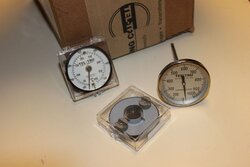Hi Everyone,
I have been reading and learning here for the past two years but this is my first post. I have a NC-30 and have a thermometer on top of the stove that will read about 550 degrees when cruising. I have another thermometer on the collar of the stove that usually reads about 300-400. I have a stainless steel flex liner that is insulated down to the collar. My question is how to I get an accurate reading of my flue temps, or does it not matter all that much? Is there a probe that I can insert in the liner?
J
I have been reading and learning here for the past two years but this is my first post. I have a NC-30 and have a thermometer on top of the stove that will read about 550 degrees when cruising. I have another thermometer on the collar of the stove that usually reads about 300-400. I have a stainless steel flex liner that is insulated down to the collar. My question is how to I get an accurate reading of my flue temps, or does it not matter all that much? Is there a probe that I can insert in the liner?
J


